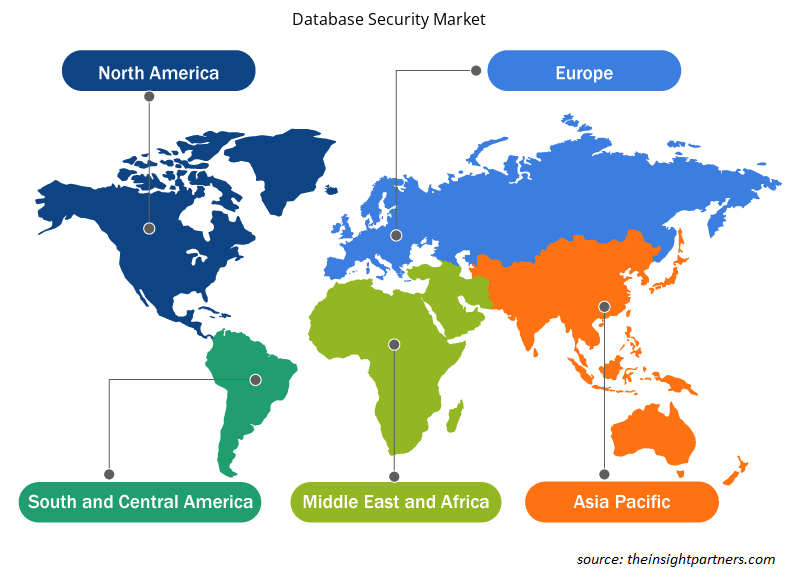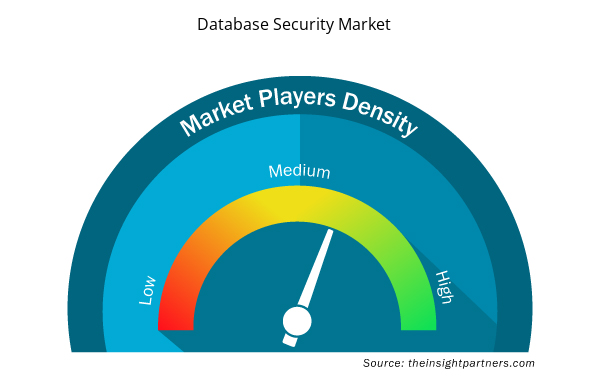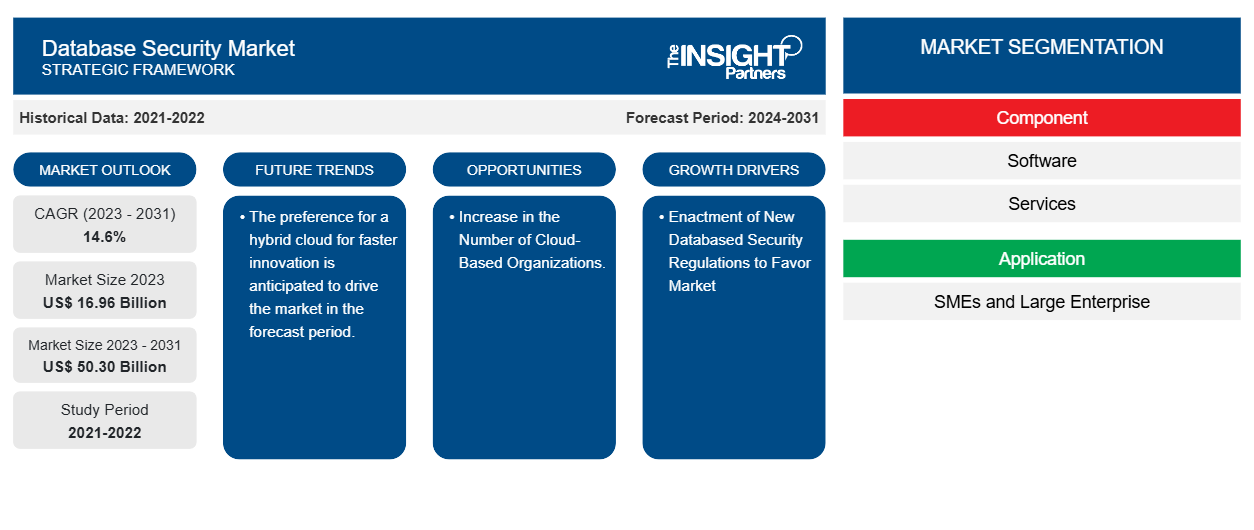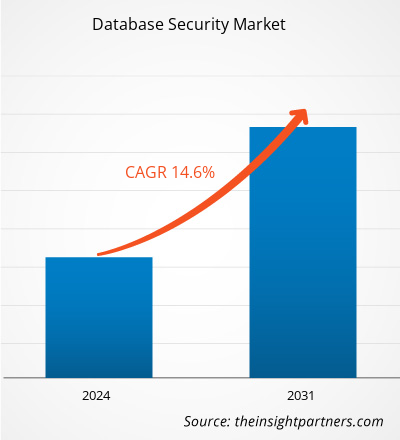Si prevede che la dimensione del mercato della sicurezza dei database raggiungerà i 50,30 miliardi di dollari entro il 2031, rispetto ai 16,96 miliardi di dollari del 2023. Si prevede che il mercato registrerà un CAGR del 14,6% nel periodo 2023-2031. L'emanazione di nuove normative sulla sicurezza dei database, i crescenti volumi di dati aziendali e l'aumento esponenziale del potenziale di attacchi informatici con la popolarità dell'IoT saranno probabilmente i principali driver e tendenze del mercato.CAGR of 14.6% during 2023–2031. The enactment of new database security regulations, growing volumes of business data and exponential rise in potential for cyberattacks with the popularity of IoT are likely to be the key drivers and trends of the market.
Analisi di mercato della sicurezza del database
Il mercato della sicurezza dei database sta vivendo una crescita significativa a livello globale. Questa crescita è attribuita a fattori quali l'emanazione di nuove normative sulla sicurezza dei database, i crescenti volumi di dati aziendali e l'aumento esponenziale del potenziale di attacchi informatici con la popolarità dell'IoT. Inoltre, si prevede che la proliferazione delle dimensioni e dei servizi delle organizzazioni basate sul cloud e la preferenza per il cloud ibrido per un'innovazione più rapida guideranno la crescita del mercato nei prossimi anni.
Panoramica del mercato della sicurezza dei database
La sicurezza dei database è considerata come la serie di controlli, strumenti e procedure progettati per garantire e salvaguardare integrità, riservatezza e accessibilità. Le leggi sulla sicurezza dei dati sono importanti per scopi che vanno oltre il semplice raggiungimento della conformità normativa . Questi includono:
- Garantire la riservatezza delle informazioni personali delle persone i cui dati vengono elaborati
- Ridurre al minimo i rischi di violazioni dei dati e minacce informatiche
- Mantenere l'affidabilità e l'accuratezza dei dati
- Creare un ambiente aziendale sano con una maggiore fiducia dei clienti
- Promuovere l'impegno verso la sicurezza informatica.
Personalizza questo report in base alle tue esigenze
Riceverai la personalizzazione gratuita di qualsiasi report, comprese parti di questo report, o analisi a livello nazionale, pacchetto dati Excel, oltre a usufruire di grandi offerte e sconti per start-up e università
- Scopri le principali tendenze di mercato in questo rapporto.Questo campione GRATUITO includerà analisi di dati che spaziano dalle tendenze di mercato alle stime e alle previsioni.
Driver e opportunità del mercato della sicurezza dei database
Emanazione di nuove norme sulla sicurezza dei database per favorire il mercato
Le normative sulla sicurezza dei database sono standard stabiliti da enti normativi o dal governo, che guidano le organizzazioni verso la protezione della riservatezza, integrità e disponibilità dei dati. Queste mirano essenzialmente a salvaguardare le risorse informative dell'azienda da distruzione, manomissione, accesso non autorizzato e altri rischi per la sicurezza. Inoltre, ci sono costi per la mancata conformità alle normative internazionali come il Sarbanes-Oxley Act (SAO) o lo standard di sicurezza dei dati del settore delle carte di pagamento (PCI DSS) specifici per le normative del settore sulla privacy dei dati, come HIPAA o leggi regionali sulla privacy come il Regolamento generale sulla protezione dei dati (GDPR) dell'Unione Europea, che potrebbero essere un problema chiave con multe nei casi peggiori superiori a molti milioni di dollari per ogni violazione.Sarbanes-Oxley Act (SAO) or payment card industry data security standard (PCI DSS) specific to industry regulations on data privacy, like HIPAA or regional privacy laws like the European Union's General Data Protection Regulation (GDPR) could be a key problem with fines in worst cases in excess of many million dollars for each violation.
Aumento del numero di organizzazioni basate sul cloud.
Ci sono un gran numero di organizzazioni basate su cloud sul mercato, tra cui AWS, VMWare, Oracle, NetApp, Salesforce, Google, IBM e molte altre. Queste organizzazioni comprendono grandi quantità di database. Considerando questo, il rischio di violazioni dei dati e phishing dei dati è aumentato. Una minaccia specifica per i database è l'introduzione di SQL non veritieri e di altri attacchi di stringhe non SQL nelle query per i database forniti da app basate sul Web e intestazioni HTTP. Le aziende che non seguono pratiche di codifica sicure per le applicazioni Web e non conducono regolari test di esposizione sono suscettibili agli attacchi che li utilizzano.VMWare, Oracle, NetApp, Salesforce, Google, IBM, and many more. These organizations comprise large amounts of databases. Considering this, the risk of data breaches and data phishing is increased. A specific threat to databases is the introducing of untrue SQL as well as other non-SQL string attacks in queries for databases delivered by web-based apps and HTTP headers. Companies that do not follow safe
Analisi della segmentazione del rapporto di mercato sulla sicurezza del database
I segmenti chiave che hanno contribuito alla derivazione dell'analisi di mercato della sicurezza dei database sono i componenti, le applicazioni e il settore verticale.verticle.
- In base al componente, il mercato della sicurezza del database è diviso in software e servizi. Si prevede che il segmento software detenga una quota di mercato significativa nel periodo di previsione.
- In base all'applicazione, il mercato della sicurezza dei database è suddiviso in PMI e grandi imprese. Si prevede che il segmento PMI deterrà una quota di mercato significativa nel periodo di previsione.SMEs and large enterprises. The SME segment is anticipated to hold a significant market share in the forecast period.
- Per settore verticale, il mercato è segmentato in BFSI, IT e telecomunicazioni, produzione, sanità, governo, vendita al dettaglio e altri). Si prevede che IT e telecomunicazioni deterranno una quota di mercato significativa nel periodo di previsione.verticle, the market is segmented into BFSI, IT and telecom, manufacturing, healthcare, government, retail, and others). The IT and telecom is anticipated to hold a significant market share in the forecast period.
Analisi della quota di mercato della sicurezza dei database per area geografica
L'ambito geografico del rapporto sul mercato della sicurezza dei database è suddiviso principalmente in cinque regioni: Nord America, Asia Pacifico, Europa, Medio Oriente e Africa, Sud e Centro America.
Il Nord America ha dominato il mercato della sicurezza dei database. Le tendenze di adozione di tecnologie elevate in vari settori nella regione nordamericana hanno alimentato la crescita del mercato della sicurezza dei database. Fattori come il crescente numero di organizzazioni basate sul cloud. Inoltre, una forte enfasi sulla ricerca e sviluppo nelle economie sviluppate degli Stati Uniti e del Canada sta costringendo i player nordamericani a portare sul mercato soluzioni tecnologicamente avanzate. Inoltre, gli Stati Uniti hanno un gran numero di player del mercato della sicurezza dei database che si sono sempre più concentrati sullo sviluppo di soluzioni innovative. Tutti questi fattori contribuiscono alla crescita del mercato della sicurezza dei database nella regione.fuelled the growth of the database security market. Factors such as the increasing number of cloud-based organizations. Moreover, a strong emphasis on research and development in the developed economies of the US and Canada is forcing the North American players to bring technologically advanced solutions into the market. In addition, the US has a large number of database security market players who have been increasingly focusing on developing innovative solutions. All these factors contribute to the region's growth of the database security market.
Approfondimenti regionali sul mercato della sicurezza dei database
Le tendenze regionali e i fattori che influenzano il Database Security Market durante il periodo di previsione sono stati ampiamente spiegati dagli analisti di Insight Partners. Questa sezione discute anche i segmenti del Database Security Market e la geografia in Nord America, Europa, Asia Pacifico, Medio Oriente e Africa e Sud e Centro America.

- Ottieni i dati specifici regionali per il mercato della sicurezza del database
Ambito del rapporto di mercato sulla sicurezza del database
| Attributo del report | Dettagli |
|---|---|
| Dimensioni del mercato nel 2023 | 16,96 miliardi di dollari USA |
| Dimensioni del mercato entro il 2031 | 50,30 miliardi di dollari USA |
| CAGR globale (2023-2031) | 14,6% |
| Dati storici | 2021-2022 |
| Periodo di previsione | 2024-2031 |
| Segmenti coperti | Per componente
|
| Regioni e Paesi coperti | America del Nord
|
| Leader di mercato e profili aziendali chiave |
|
Densità degli attori del mercato della sicurezza dei database: comprendere il suo impatto sulle dinamiche aziendali
Il mercato della sicurezza dei database sta crescendo rapidamente, spinto dalla crescente domanda degli utenti finali dovuta a fattori quali l'evoluzione delle preferenze dei consumatori, i progressi tecnologici e una maggiore consapevolezza dei vantaggi del prodotto. Con l'aumento della domanda, le aziende stanno ampliando le loro offerte, innovando per soddisfare le esigenze dei consumatori e capitalizzando sulle tendenze emergenti, il che alimenta ulteriormente la crescita del mercato.
La densità degli operatori di mercato si riferisce alla distribuzione di aziende o società che operano in un particolare mercato o settore. Indica quanti concorrenti (operatori di mercato) sono presenti in un dato spazio di mercato in relazione alle sue dimensioni o al valore di mercato totale.
Le principali aziende che operano nel mercato della sicurezza dei database sono:
- Società anonima
- SAP SE
- ScalaGriglia
- MICROFOCUS
- Talete
- Società Oracle
Disclaimer : le aziende elencate sopra non sono classificate secondo un ordine particolare.

- Ottieni una panoramica dei principali attori del mercato della sicurezza dei database
Notizie di mercato e sviluppi recenti sulla sicurezza dei database
Il mercato della sicurezza dei database viene valutato raccogliendo dati qualitativi e quantitativi dopo la ricerca primaria e secondaria, che include importanti pubblicazioni aziendali, dati associativi e database. Di seguito sono elencati alcuni degli sviluppi nel mercato della sicurezza dei database:
- Microsoft Corp. e Oracle stanno ampliando la collaborazione per soddisfare la crescente domanda dei clienti per Oracle Database@Azure in tutto il mondo. Oracle Database@Azure si espanderà in altre cinque regioni, il che porta l'impronta di disponibilità multicloud pianificata totale a 15 regioni a livello globale. (Fonte: Oracle Company Website, marzo 2024)
- CrowdStrike e Cloudflare, Inc., l'azienda leader nel cloud per la connettività, stanno espandendo la loro partnership strategica per connettere le loro piattaforme e migliorare la sicurezza dal dispositivo alla rete, accelerare la trasformazione del Security Operations Center (SOC) e fermare le violazioni prima che si verifichino. (Fonte: sito Web aziendale CrowdStrike, giugno 2024)
Copertura e risultati del rapporto sul mercato della sicurezza dei database
Il rapporto "Dimensioni e previsioni del mercato della sicurezza dei database (2021-2031)" fornisce un'analisi dettagliata del mercato che copre le seguenti aree:
- Dimensioni e previsioni del mercato della sicurezza dei database a livello globale, regionale e nazionale per tutti i segmenti di mercato chiave coperti dall'ambito
- Tendenze del mercato della sicurezza dei database e dinamiche di mercato come driver, limitazioni e opportunità chiave
- Analisi dettagliata delle cinque forze PEST/Porter e SWOT
- Analisi di mercato sulla sicurezza dei database che copre le principali tendenze del mercato, il quadro globale e regionale, i principali attori, le normative e i recenti sviluppi del mercato
- Analisi del panorama industriale e della concorrenza che copre la concentrazione del mercato, l'analisi della mappa di calore, i principali attori e gli sviluppi recenti per il mercato della sicurezza dei database
- Profili aziendali dettagliati
- Analisi storica (2 anni), anno base, previsione (7 anni) con CAGR
- Analisi PEST e SWOT
- Valore/volume delle dimensioni del mercato - Globale, regionale, nazionale
- Industria e panorama competitivo
- Set di dati Excel



Report Coverage
Revenue forecast, Company Analysis, Industry landscape, Growth factors, and Trends

Segment Covered
This text is related
to segments covered.

Regional Scope
North America, Europe, Asia Pacific, Middle East & Africa, South & Central America

Country Scope
This text is related
to country scope.
Domande frequenti
The global database security market is expected to reach US$ 50.30 billion by 2031.
The key players holding majority shares in the global database security market are Datasparc Inc., SAP SE, ScaleGrid, MICRO FOCUS, Thales, Oracle Corporation, IBM Corporation, Fortinet, and Trustwave.
The preference for a hybrid cloud for faster innovation is anticipated to drive the market in the forecast period.
The enactment of new database security regulations, growing volumes of business data and exponential rise in potential for cyberattacks with the popularity of IoT are some of the factors driving the database security market.
North America is anticipated to dominate the database security market in 2023.
The expected CAGR of the database security market is 14.6%.
Trends and growth analysis reports related to Technology, Media and Telecommunications : READ MORE..
The Insight Partners performs research in 4 major stages: Data Collection & Secondary Research, Primary Research, Data Analysis and Data Triangulation & Final Review.
- Data Collection and Secondary Research:
As a market research and consulting firm operating from a decade, we have published and advised several client across the globe. First step for any study will start with an assessment of currently available data and insights from existing reports. Further, historical and current market information is collected from Investor Presentations, Annual Reports, SEC Filings, etc., and other information related to company’s performance and market positioning are gathered from Paid Databases (Factiva, Hoovers, and Reuters) and various other publications available in public domain.
Several associations trade associates, technical forums, institutes, societies and organization are accessed to gain technical as well as market related insights through their publications such as research papers, blogs and press releases related to the studies are referred to get cues about the market. Further, white papers, journals, magazines, and other news articles published in last 3 years are scrutinized and analyzed to understand the current market trends.
- Primary Research:
The primarily interview analysis comprise of data obtained from industry participants interview and answers to survey questions gathered by in-house primary team.
For primary research, interviews are conducted with industry experts/CEOs/Marketing Managers/VPs/Subject Matter Experts from both demand and supply side to get a 360-degree view of the market. The primary team conducts several interviews based on the complexity of the markets to understand the various market trends and dynamics which makes research more credible and precise.
A typical research interview fulfils the following functions:
- Provides first-hand information on the market size, market trends, growth trends, competitive landscape, and outlook
- Validates and strengthens in-house secondary research findings
- Develops the analysis team’s expertise and market understanding
Primary research involves email interactions and telephone interviews for each market, category, segment, and sub-segment across geographies. The participants who typically take part in such a process include, but are not limited to:
- Industry participants: VPs, business development managers, market intelligence managers and national sales managers
- Outside experts: Valuation experts, research analysts and key opinion leaders specializing in the electronics and semiconductor industry.
Below is the breakup of our primary respondents by company, designation, and region:

Once we receive the confirmation from primary research sources or primary respondents, we finalize the base year market estimation and forecast the data as per the macroeconomic and microeconomic factors assessed during data collection.
- Data Analysis:
Once data is validated through both secondary as well as primary respondents, we finalize the market estimations by hypothesis formulation and factor analysis at regional and country level.
- Macro-Economic Factor Analysis:
We analyse macroeconomic indicators such the gross domestic product (GDP), increase in the demand for goods and services across industries, technological advancement, regional economic growth, governmental policies, the influence of COVID-19, PEST analysis, and other aspects. This analysis aids in setting benchmarks for various nations/regions and approximating market splits. Additionally, the general trend of the aforementioned components aid in determining the market's development possibilities.
- Country Level Data:
Various factors that are especially aligned to the country are taken into account to determine the market size for a certain area and country, including the presence of vendors, such as headquarters and offices, the country's GDP, demand patterns, and industry growth. To comprehend the market dynamics for the nation, a number of growth variables, inhibitors, application areas, and current market trends are researched. The aforementioned elements aid in determining the country's overall market's growth potential.
- Company Profile:
The “Table of Contents” is formulated by listing and analyzing more than 25 - 30 companies operating in the market ecosystem across geographies. However, we profile only 10 companies as a standard practice in our syndicate reports. These 10 companies comprise leading, emerging, and regional players. Nonetheless, our analysis is not restricted to the 10 listed companies, we also analyze other companies present in the market to develop a holistic view and understand the prevailing trends. The “Company Profiles” section in the report covers key facts, business description, products & services, financial information, SWOT analysis, and key developments. The financial information presented is extracted from the annual reports and official documents of the publicly listed companies. Upon collecting the information for the sections of respective companies, we verify them via various primary sources and then compile the data in respective company profiles. The company level information helps us in deriving the base number as well as in forecasting the market size.
- Developing Base Number:
Aggregation of sales statistics (2020-2022) and macro-economic factor, and other secondary and primary research insights are utilized to arrive at base number and related market shares for 2022. The data gaps are identified in this step and relevant market data is analyzed, collected from paid primary interviews or databases. On finalizing the base year market size, forecasts are developed on the basis of macro-economic, industry and market growth factors and company level analysis.
- Data Triangulation and Final Review:
The market findings and base year market size calculations are validated from supply as well as demand side. Demand side validations are based on macro-economic factor analysis and benchmarks for respective regions and countries. In case of supply side validations, revenues of major companies are estimated (in case not available) based on industry benchmark, approximate number of employees, product portfolio, and primary interviews revenues are gathered. Further revenue from target product/service segment is assessed to avoid overshooting of market statistics. In case of heavy deviations between supply and demand side values, all thes steps are repeated to achieve synchronization.
We follow an iterative model, wherein we share our research findings with Subject Matter Experts (SME’s) and Key Opinion Leaders (KOLs) until consensus view of the market is not formulated – this model negates any drastic deviation in the opinions of experts. Only validated and universally acceptable research findings are quoted in our reports.
We have important check points that we use to validate our research findings – which we call – data triangulation, where we validate the information, we generate from secondary sources with primary interviews and then we re-validate with our internal data bases and Subject matter experts. This comprehensive model enables us to deliver high quality, reliable data in shortest possible time.


 Ottieni un campione gratuito per questo repot
Ottieni un campione gratuito per questo repot